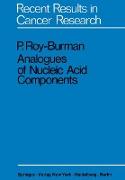Analogues of Nucleic Acid Components
BücherAngebote / Angebote:
The rationale for the design of structural analogues of a normal metabolite is that such compounds may interfere in the utilization or function of the metabolite. A compound which is effective in this respect may be called an antimetabolite. To be successful in chemotherapy of bacterial, viral, or tumor growth, an antimetabolite should adversely affect some vital metabolic reactions in the parasite or parasitic tissue without seriously endangering the host tissue. If a metabolic process of the offending growth is different from that of the host, it is likely that the metabolism or activity of a compound, structurally related to a metabolite involved in that process, will also be different in these cells. Such differences are useful for devising effective drugs with selective actions. Sulfanilamide, a structural analogue of para aminobenzoic acid, interferes with the utilization of this metabolite in the synthesis of folic acid, an essential factor for growth. Bacteria synthesize their own folic acid and are incapable of utilizing exogenously available folic acid. However, the situation is exactly opposite in the animal host. That is, animal tissues cannot synthesize folic acid and are absolutely dependent upon exogenous sources. These differences in metabolism make possible the use of sulfanilamide as a selective inhibitor of growth. Other antibacterial or antiparasitic drugs, such as penicillin (BURCHALL, FERONE and HITCHINGS, 1965) and inhibitors of dihydrofolate reductase (HITCHINGS and BURCHALL, 1965, HITCHINGS, 1964, BURCHALL and HITCHINGS, 1965) have analogous desirable selective toxicity effects.
Folgt in ca. 5 Arbeitstagen

